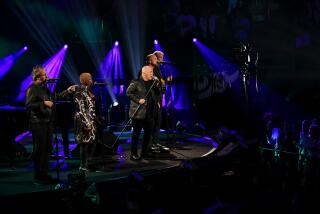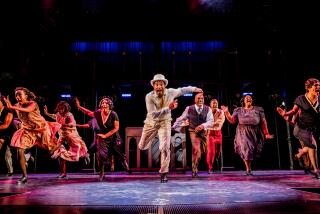POP MUSIC REVIEW : Goodness, Gracious--Just a Little More?
- Share via
CERRITOS — Please, Mr. Lewis, your excellency, killership, sir , can we have some more?
Just one or two more minutes of Jerry Lee Lewis’s piano pounding and wild-eyed carrying on at the end of an uproarious, show-closing “Great Balls of Fire” Friday night would have meant the difference between glimpsing the rock ‘n’ roll equivalent of the Holy Grail, which is all that we mere mortals can really hope for on any given night, and getting a good, gullet-filling gulp of its intoxicating contents.
Instead, the 59-year-old rock icon, responding to some idiosyncratic inner alarm clock that had been going off abruptly throughout his performance at the Cerritos Center for the Performing Arts, decided not to overindulge our appetite for definitive rock ‘n’ roll moments. Even without that craved extra minute, “Great Balls of Fire” and the 13 never-moldy oldies that went before it in an evening of fine-form Jerry Lee should keep us buzzed until Lincoln’s Birthday.
For that splendid finale, Lewis summoned all the tear-it-up spirit of primal ‘50s rock, complete with whooping, jubilant vocal and the sort of magically alive piano sorcery he’d been spinning all night.
At the end, with his accustomed look of regal command giving way to a wicked grin, Lewis kicked away his piano bench, did a rump-first leap onto his keyboard, and pounded and jabbed some more before abruptly departing the spinning stage while his band-befitting-a-hall-of-famer continued to wail. It looked for a moment as if Jerry Lee was going to take a victory lap around the intimate, box-shaped house, but in actuality he had just lost his bearings. A guard helped him to the backstage exit he’d been seeking. But had he taken that lap, it would have been well-earned.
As a whole, Lewis’s 50-minute show was a short but satisfying sampler of familiar pleasures.
He kept a balance between the pumping rock ‘n’ roll that made him famous in the 1950s, and the countrified balladry that gave his recording career a second wind in the ‘60s and ‘70s. There were no previews of songs from “Memphis,” the new album, due out next month, with which Lewis will try to re-establish himself as a ‘90s recording artist after a long layoff from the studio.
Besides his own foremost rock hits, “High School Confidential,” “Whole Lotta Shakin’ Going On” and “Great Balls of Fire,” Lewis drew from the catalogues of Hank Williams (“You Win Again,” “Hey, Good Lookin”’) and Chuck Berry (“Sweet Little Sixteen,” “Roll Over Beethoven”), tossed in ribald nuggets like “Chantilly Lace” and “Lucille,” and left room for lamentation on “Over the Rainbow” and “Georgia on My Mind.”
But no matter how familiar the borrowed material might be, Lewis’ imposing musical personality allowed him to turn it into his own material.
His approach on downcast ballads was notable for his refusal to sound repentant or truly anguished. Instead, “Over the Rainbow” and “Georgia on My Mind” struck an emotional note somewhere between stoicism and defiance. Both acknowledged the hurting side of life and endorsed the idea that singing one’s woes is simply the human thing to do. But Lewis maintained a crusty composure as well, the firmness of tone of a man who doesn’t have any illusions left about flying over rainbows, and is willing to face up, without bitterness, to the harsh reality he’s found.
The rockers were rumbles--due partly to a slamming, four-man band that seemed intent on giving us the grunge-rock version of ‘50s rock ‘n’ roll, and partly to a questionable sound mix that took a toll on vocal clarity, squeezed the guitars, and made some of Lewis’ between-songs remarks hard to decipher, although it was obvious he was in an affable mood.
The guitarists, one estimable (Kenny Lovelace, a member of Lewis’ bands for 28 years) and the other legendary (James Burton, whose ‘50s playing with Ricky Nelson offered a primer for many a subsequent guitarist) got their sweetest licks in on the ballads, and during a 17-minute opening sequence before Lewis arrived on stage.
The warm-up also included two songs sung by Kerry Lewis, the eighth Mrs. Killer. She did serviceable turns as a red-hot mama in the style of Bonnie Raitt and Tanya Tucker.
One could gripe about the rotating-stage format, which is always a compromise for rock acts and singers who need to be surrounded by their bands, and about the substitution of an inevitably thin, ringy-sounding digital piano for the real thing. But Lewis’ personality was large enough to come through despite blocked sight lines, and his piano playing was the show’s essential element, the fullest measure of his greatness.
As he played, Lewis would set his face in an imperious, firm-jawed look, with thin-lipped mouth curled downward at the sides. Leaning back on his stool, arms outstretched like a conjurer’s, he proceeded to play with the arrogance of command, as if he were a monarch making his court jump at every whim. (Like many a king, Lewis tends to refer to himself in the third person: The unofficial score card from Friday night indicates that he called himself “Jerry Lee” or “Jerry Lee Lewis” 15 times, and “Killer” an additional four.)
Jabbing notes with an index finger, executing hand-over-hand zings and rolls that were the manual equivalent of a Michael Jackson moon walk, Lewis at his keyboard was a vision of sheer prowess and excitement, a rock ‘n’ roll parallel to a young Muhammad Ali floating and stinging in the boxing ring, or to Harry Houdini breaking out of straitjackets and chains.
(We would normally say right about here that Lewis’ only equal for rock ‘n’ roll piano excitement is Little Richard, but Richard is in our dog house following his miserable show last year at the Coach House.)
As the details of his chaotic personal life attest, Lewis is no normal human being, and probably not a fellow with whom most of us would want to have personal dealings. But channeled through a piano, his wildness and his determination to bend the world to his will give rise to an unsurpassed wonder of rock ‘n’ roll.
It’s going on 38 years since “Great Balls of Fire,” and the wonder hasn’t ceased.
*
Charlie Musselwhite, who opened with a wide-ranging set of tradition-steeped blues, is as unpresumptuous a performer as Lewis is flashy. The veteran harmonica player’s 55-minute show was impressive for its command of a variety of blues styles, and for the strength and purity of the playing.
Musselwhite, a weathered-looking 50, grew up in Memphis, gravitated to Chicago in his late teens, and emerged with his first album in 1966, putting him just a beat or two behind John Hammond and the Paul Butterfield Blues Band as part of the original generation of white American blues lovers who followed in the footsteps of black mentors.
His set showed how much he has absorbed, as it touched on raunchy Chicago-style shuffles, a darkly driving boogie in the John Lee Hooker mold, and an interlude of front-porch country blues. The performance peaked with Musselwhite’s mournful, waltz-time slow-blues signature instrumental, “Christo Redemptor.”
Musselwhite’s singing was low-keyed and conversational, and his stage presence was similarly understated. The show was founded on an unforced, to-the-point exhibition of blues harp’s expressive possibilities--moaning, shrieking, playfully skipping and gliding, but never carried into exaggeration or excess.
A vigorous rhythm section framed the tunes and a sharp, tasteful guitarist, Andrew (Junior Boy) Jones, gave Musselwhite a worthy foil and sparring partner by mustering a clean, beautifully defined tone.
A few others (Orange County’s James Harman comes to mind) can offer the same level of nuance, expertise, variety and deep affinity for traditional blues, while putting on a far more zestful show. But that’s not to say that Musselwhite’s style (well-represented on his latest album, the Grammy-nominated “In My Time”) isn’t worth pausing to savor.
More to Read
The biggest entertainment stories
Get our big stories about Hollywood, film, television, music, arts, culture and more right in your inbox as soon as they publish.
You may occasionally receive promotional content from the Los Angeles Times.











